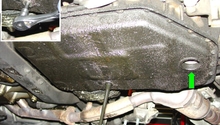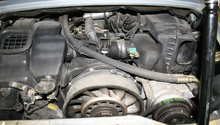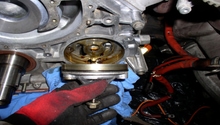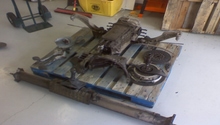Porsche 928: How to Change Manual Transmission Fluid
It's often overlooked, but your manual transmission fluid needs to be changed also. This article will guide you step-by-step on how to change the manual transmission fluid in your Porsche 928.
This article applies to the Porsche 928 (1978-1995).
There are numerous different fluids that need to be changed in your car in order to keep it working properly. Many owners overlook the fact that there is fluid in the manual transmission, which needs to be changed out at certain intervals. While these intervals are not as frequent as engine oil intervals, it pays to keep them consistent.
The manual transmission on the Porsche 928 is actually a trans-axle design. This means that the transmission and final drive are part of the same unit, which drives the rear wheels. What is great about this setup is that when you go to change your manual transmission fluid, you can also knock out the final drive or differential fluid at the same time.

Materials Needed
- 17mm hex socket
- Breaker bar
- Jack
- Jack stands or ramps
- Container or pan
Before you start, you will need to figure out what kind of fluid your car is going to require. To do this, you will need to know if your car is equipped with a Limited Slip Differential (LSD), or not. A car that is equipped with an LSD will require the fluid to have friction modifiers in it in order to operate. A car that is not equipped with an LSD differential will not require those same friction modifiers.
Step 1 – Elevate the car
The manual transmission on the Porsche 928 is located in the rear of the car. So, you will need to elevate the car in order to gain access to it. You can back it up on ramps, or place the car on jack stands, whichever works best for you. If you have access to a lift, that will work also. The more leveled the car can stay, the better. This will help in the draining of the old fluid.
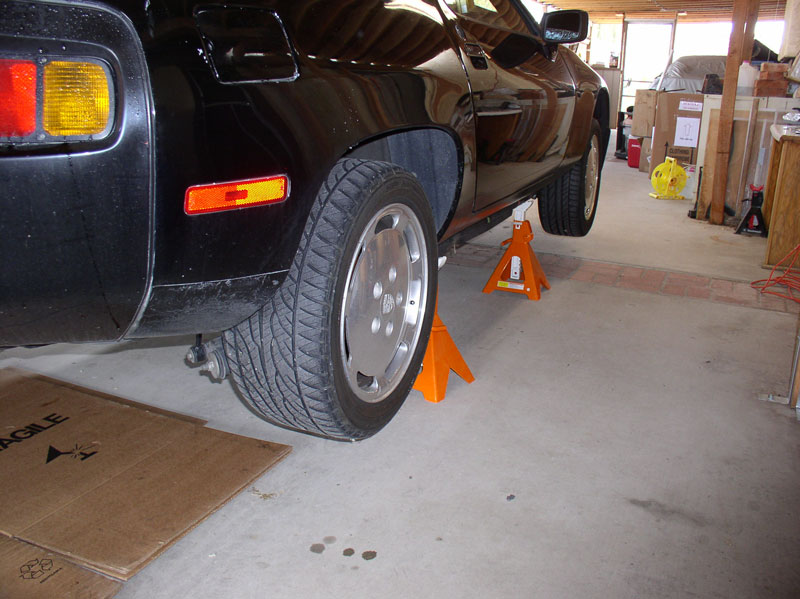
Step 2 – Remove the fill plug
The Porsche 928 has three plugs on the transmission and rear differential assembly. Two are drain plugs, and one is a fill plug. They are all 17mm hex plugs. The fill plug is located on the rear cover of the assembly, and it should be the plug that is higher up on the rear cover than the other plug. You will want to remove the fill plug first because if you can't (for any reason) get it loose, then at least you haven't drained your fluid out. Using your breaker bar and 17mm hex socket, loosen the plug.

Step 3 – Loosen the drain plugs
There are two drain plugs. One towards the front/middle of the transmission assembly, and the other on the rear cover below the fill plug. Loosen these plugs with your 17mm hex socket and breaker bar. Make sure you have a clean suitable container or pan to catch the old fluid when it comes out. When you remove these plugs, you will probably notice a lot of metal collected on the drain plug. These plugs are magnetic, and will catch metallic particles that are in the fluid. It is normal for them to buildup on this drain plug, and as long as they are not big or chunky, there is nothing to worry about. Just make sure you clean them off before you re-install them. Once the fluid has drained, you can re-install the plugs. Also, before re-installing, make sure you replace the crush washers on the plug.

Step 4 – Fill transmission assembly with new fluid
You can now fill the transmission assembly with new fluid. You will notice a difficulty in getting the fluid into the fill plug hole. There are many creative ways of doing this, and you can pick up a basic hand pump at your local auto parts store for easy filling. The fluid capacity of the transmission assembly is approximately 3.8 liters. Re-install the fill plug when you are finished.

Step 5 – Lower the car and test drive
After you are done filling the transmission with new fluid, you can lower the car back down to take it for a test drive. Park the car, and check for leaks. If everything checks out, then you are done.
Featured Video: Transmission Oil Change
Related Discussions
- How Do I Change the Transmission Fluid - Rennlist.com
- 928 Trans and Diff Question - Rennlist.com
- Adding Trans Fluid to 928 - Rennlist.com
- Do's and Dont's Trans Fluid - Rennlist.com
- 928 Lubricant List - Rennlist.com

